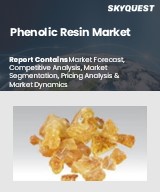
Report ID: SQMIG15A2495
Skyquest Technology's expert advisors have carried out comprehensive research on the phenolic resin market to identify the major global and regional market trends and growth opportunities for leading players and new entrants in this market. The analysis is based on in-depth primary and secondary research to understand the major market drivers and restraints shaping the future development and growth of the industry.
Enhanced Material Properties Driving Adoption
Increasing Understanding of Usage and Applicability to Drive Market
Environmental Regulations to Restrict Market Growth
Volatility in Raw Material Prices
REQUEST FOR SAMPLE
Global Phenolic Resin Market size was valued at USD 14.35 Billion in 2023 and is poised to grow from USD 15.14 Billion in 2024 to USD 23.23 Billion by 2032, growing at a CAGR of 5.5% in the forecast period (2025-2032).
The phenolic resin market is characterized by fierce competition among key players focused on innovation, sustainability and expanding their global footprint. Established companies and local players operating in this market cater to various end-use industries such as automotive, manufacturing, electronics, aerospace Major strategies used by market players roles and mergers and acquisitions, partnerships, product launches, and technological developments for competitive advantage. Leading companies such as Hexion Inc., Sumitomo Bakelite Co., Ltd., BASF SE, Kolon Industries, Inc. are all involved. and SI Group dominate the market. These companies invest heavily in research and development to produce high performance, environmentally friendly advanced phenolic resins. 'Bakelite Synthetics (U.S)', 'Sumitomo Bakelite Company Limited (Japan)', 'SI Group Inc. (U.S)', 'Jinan Shengquan Group Share Holding Co. Ltd. (China)', 'Ashland Global Holdings Inc. (the U.S)', 'BASF SE (Germany)', 'Georgia-Pacific Chemicals' (U.S)', 'DIC Corp (Japan)', 'Hexcel Corporation (U.S)', 'Akrochem Corporation (U.S)', 'Arclin Inc', 'Olympic Panel Products LLC', 'Ashland Inc', 'Momentive Specialty Chemicals', 'BASF SE', 'Hitachi Chemical Co. Ltd'
Phenolic resins are extensively utilized in various industries due to their increased qualities, such as intense heat resistance, high moldability, mechanical strength, low toxicity of smoke, and ability to combine with polymers. Phenolic resins are used as a durable binder and adhesive in structural wood panels and a binder in mineral wool insulation due to their water resistance. They are used in the automotive and construction industries for brake linings, insulating foams, foundry binders, and composites due to their excellent thermal stability and fire resistance.
Growing Need for Fuel-Efficient and Lightweight Automobiles to Spur Market Opportunities: Continuous advancements in the automotive and transportation industries have generated substantial demand for fuel-efficient, lightweight automobiles. Companies use lightweight materials, such as aluminum, steel, composites, and polymers, to make autos lightweight and fuel-efficient. In a car, adhesives reduce the need for fasteners such as welds, rivets, and bolts. Utilizing superior materials and adhesives enhances the crush and impact resistance of automobiles. These factors are anticipated to increase demand for phenolic resins.
Asia Pacific dominated the phenolic resin market in 2024 with a market share of more than 30.0% and is expected to witness significant growth over the forecast period. The region is dominating owing to the strong economic development coupled with substantial investment in various industries including automotive, building & construction, electrical & electronics, and others. Furthermore, escalating construction activities, rapidly growing demand for residential as well as expanding middle-class population are key factors boosting the demand for phenolic resins. Combined with surged disposable income and increasing investments in housing, these factors are fueling growth in emerging economies. Additionally, the rising demand for automotive production, including the surge in electric vehicles (EVs), is expected to further drive phenolic resin consumption.
Want to customize this report? This report can be personalized according to your needs. Our analysts and industry experts will work directly with you to understand your requirements and provide you with customized data in a short amount of time. We offer $1000 worth of FREE customization at the time of purchase.
Feedback From Our Clients

Report ID: SQMIG15A2495
sales@skyquestt.com
USA +1 351-333-4748